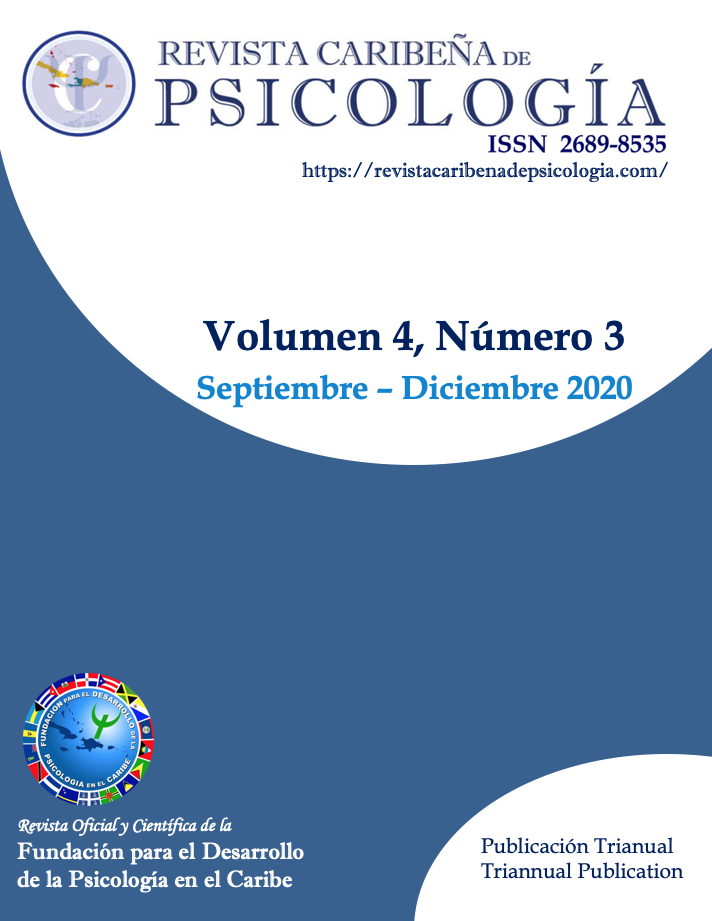Trastorno del Espectro Autista en Féminas
DOI:
https://doi.org/10.37226/rcp.v4i3.4851Palabras clave:
autismo en féminas, autismo en mujeres, autismo en niñas y adolescentes, Trastorno del Espectro AutistaResumen
Estudios epidemiológicos indican que el Trastorno del Espectro Autista (TEA) es diagnosticado con mayor frecuencia en varones que en féminas. Investigadores han propuesto que es posible que esto se deba a: subestimación y fallos en la detección del autismo en las féminas, camuflaje de síntomas en las féminas, métodos de evaluación utilizados y/o a sesgos por parte de los profesionales al diagnosticar, entre otros. Este trabajo se propone analizar aspectos relacionados a la presentación del autismo en féminas, explorar condiciones comórbidas en esta población, y examinar los retos asociados a los procedimientos diagnósticos.
Citas
Aggarwal, S. & Angus, B. (2015). Misdiagnosis versus missed diag-nosis: diagnosing autism spectrum disorder in adolescents. Australasian Psychiatry, 23(2), 120-123. https://doi.org/10.1177/1039856214568214
Allely, C. S. (2019). Exploring the female autism phenotype of repetitive behaviours and restricted interests (RBRIs): a sys-tematic PRISMA review. Advances in Autism, 5(3), 171–186. https://doi.org/10.1108/aia-09-2018-0030
Antezana, L., Factor, R. S., Condy, E. E., Strege, M. V., Scarpa, A., & Richey, J. A. (2019). Gender differences in restricted and repetitive behaviors and interests in youth with autism. Au-tism Research, 12(2), 274-283. https://doi.org/10.1002/aur.2049
Asociación Americana de Psiquiatría. (2014). Manual diagnóstico y estadístico de los trastornos mentales (DSM-5®) (5ta ed.). Edito-rial Médica Panamericana.
Attwood, T., Garnett, M. S., & Rynkiewicz, A. (2011). Question-naire for Autism Spectrum Conditions (Q-ASC). [Instrumento de Medición].
Avni, E., Ben-Itzchak, E., & Zachor, D. A. (2018). The presence of comorbid ADHD and anxiety symptoms in autism spectrum disorder: Clinical presentation and predictors. Frontiers in Psy-chiatry, 9, 717. https://doi.org/10.3389/fpsyt.2018.00717
Baldwin, S., & Costley, D. (2016). The experiences and needs of female adults with high-functioning autism spectrum disor-der. Autism, 20(4), 483–495. https://doi.org/10.1177/1362361315590805
Bargiela, S., Steward, R., & Mandy, W. (2016). The experiences of late-diagnosed women with autism spectrum conditions: An investigation of the female autism phenotype. Journal of Au-tism and Developmental Disorders, 46(10), 3281-3294. https://doi.org/10.1007/s10803-016-2872-8
Begeer, S., Mandell, D., Wijnker-Holmes, B., Venderbosch, S., Rem, D., Stekelenburg, F., & Koot, H.M. (2013). Sex differ-ences in the timing of identification among children and adults with autism spectrum disorders. Journal of Autism and Developmental Disorders, 43(5), 1151-1156. https://doi.org/10.1007/s10803-012-1656-z
Boothe, A., & Zuna, N. (2018). Epilepsy in children with ASD: An overview of evaluation procedures, child characteristics and treatment options. International Journal of Disability, De-velopment and Education, 66(1), 1-18. https://doi.org/10.1080/1034912X.2018.1437893
Cawthorpe, D. (2017). Comprehensive description of comorbidity for autism spectrum disorder in a general population. The Permanente Journal, 21, 16-088. https://doi.org/10.7812/TPP/16-088
Centers for Disease Control and Prevention. (2020). Data & Statis-tics on Autism Spectrum Disorder. https://www.cdc.gov/ncbddd/autism/data.html
Chawarska, K., Paul, R., Klin, A., Hannigen, S., Dichtel, L. E., & Volkmar, F. (2006). Parental recognition of developmental problems in toddlers with autism spectrum disorders. Journal of Autism and Developmental Disorders, 37(1), 62-72. https://doi.org/10.1007/s10803-006-0330-8
Cooper, K., Smith, L. G., & Russell, A. J. (2018). Gender identity in autism: Sex differences in social affiliation with gender groups. Journal of Autism and Developmental Disorders, 48(12), 3995-4006. https://doi.org/10.1007/s10803-018-3590-1
Cordero, J. F., Alonso Amador, A., Mattei, H., & Torres, I. M. (2012). Prevalencia de autismo en la niñez en Puerto Rico: Informe de resultados de la encuesta del 2011. Escuela de Salud Pública, Recinto de Ciencias Médicas, Universidad de Puerto Rico https://www.salud.gov.pr/SobretuSalud/Documents/Autismo/InformeEncuestaAutismoFinal2012.pdf
Croen, L. A., Zerbo, O., Qian, Y., Massolo, M. L., Rich,, S., Sidney, S., & Kripke, C. (2015). The health status of adults on the au-tism spectrum. Autism, 19(7), 814-823. https://doi.org/10.1177/1362361315577517
Dean, M., Harwood, R., & Kasari C. (2017) The art of camouflage: Gender differences in the social behaviors of girls and boys with autism spectrum disorder. Autism, 21(6), 678-689. https://doi.org/10.1177/1362361316671845
Dell'Osso, L., Ivan, M. C., Carpita, B., Fagiolini, A., Massimetti, G., Bossini, L., Vita, A., Barlati, S., Carmassi, C., & Gesi, C. (2018). Correlates of autistic traits among patients with borderline personality disorder. Comprehensive Psychiatry, 83, 7-11. https://doi.org/10.1016/j.comppsych.2018.01.002
Dewinter, J., De Graaf, H., & Begeer, S. (2017). Sexual orientation, gender identity, and romantic relationships in adolescents and adults with autism spectrum disorder. Journal of Autism and Developmental Disorders, 47(9), 2927-2934. https://doi.org/10.1007/s10803-017-3199-9
Duvekot, J., Van der Ende, J., Verhulst, F. C., Slappendel, G., Van Daalen, E., Maras, A., & Greaves-Lord, K. (2016). Factors in-fluencing the probability of a diagnosis of autism spectrum disorder in girls versus boys. Autism, 21(6), 646-658. https://doi.org/10.1177/1362361316672178
Dudas, R. B., Lovejoy, C., Cassidy, S., Allison, C., Smith, P., & Bar-on-Cohen, S. (2017). The overlap between autistic spectrum conditions and borderline personality disorder. PLUS ONE, 12(9): e0184447. https://doi.org/10.1371/journal.pone.0184447
Dworzynski, K., Ronald, A., Bolton, P., & Happé, F. (2012). How different are girls and boys above and below the diagnostic threshold for autism spectrum disorders?. Journal of the Ameri-can Academy of Child & Adolescent Psychiatry, 51(8), 788-797. https://doi.org/10.1016/j.jaac.2012.05.018
Eaton, J. (2018). A guide to mental health issues in girls and young women on the autism spectrum: Diagnosis, Intervention and family support. Jessica Kingsley Publishers.
Eckerd, M. (2020). Detection and diagnosis of ASD in females. Journal of Health Service Psychology, 46(1), 37-47. https://doi.org/10.1007/s42843-020-00006-1
Ekman, E., & Hiltunen, A. J. (2015). Modified CBT using visuali-zation for autism spectrum disorder (ASD), anxiety and avoidance behavior - a quasi-experimental open pilot study. Scandinavian Journal of Psychology, 56(6), 641–648. https://doiorg.ucapr.cobimet3.org/10.1111/sjop.12255
Eriksson, M., Marschik, P. B., Tulviste T., Almgren M., Pérez Pe-reira M., Wehberg S., Marjanovič-Umek, L., Gayraud, F., Kovacevic, M., & Gallego,C. (2012). Differences between girls and boys in emerging language skills: evidence from 10 lan-guage communities. The British journal of Developmental Psy-chology, 30, 326–343. https://doi.org10.1111/j.2044-835X.2011.02042.x
Frazier, T. W., Georgiades, S., Bishop, S. L., & Hardan, A. Y. (2014). Behavioral and cognitive characteristics of females and males with autism in the Simons Simplex Collection. Journal of the American Academy of Child & Adolescent Psychiatry, 53(3), 329-340.e3. https://doi.org/10.1016/j.jaac.2013.12.004
Frazier, T. W., & Hardan, A. Y. (2016). Equivalence of symptom dimensions in females and males with autism. Autism, 21(6), 749-759. https://doi.org/10.1177/1362361316660066
Fernell, E., Eriksson, M. A., & Gillberg, C. (2013). Early diagnosis of autism and impact on prognosis: a narrative review. Clinical Epidemiology, 5, 33. https://doi.org/10.2147/clep.s41714
Gallardo-Paúls, B. (2009). Valoración del componente pragmático a partir de datos orales. Revista de Neurología, 48(2), S57-S6. https://doi.org/10.33588/rn.48S02.2008736
Gjevik, E., Eldevik, S., Fjæran-Granum, T., & Sponheim E. (2011). Kiddie-SADS reveals high rates of DSM-IV disorders in chil-dren and adolescents with autism spectrum disorders. Journal of Autism and Developmental Disorders, 41(6), 761–769. http://dx.doi.org/10.1007/s10803-010-1095-7
González, M., Vasquez, M., & Hernandez-Chavez, M. (2019). Trastorno del espectro autista: Diagnóstico clínico y test ADOS. Revista Chilena de Pediatría, 90(5), 485-491. http://dx.doi.org/10.32641/rchped.v90i5.872
Gotham, K., Brunwasser, S. M., & Lord, C. (2015). Depressive and anxiety symptom trajectories from school age through young adulthood in samples with autism spectrum disorder and developmental delay. Journal of the American Academy of Child & Adolescent Psychiatry, 54(5), 369-379. https://doi.org/10.1016/j.jaac.2015.02.005
George, R., & Stokes, M. A. (2018). Gender identity and sexual orientation in autism spectrum disorder. Autism, 22(8), 970-982. https://doi.org/10.1177/1362361317714587
Greenlee, J. L., Mosley, A. S., Shui, A. M., Veenstra-VanderWeele, J., & Gotham, K. (2016). Medical and behavioral correlates of depression history in children and adolescents with autism spectrum disorder. Pediatrics, 137(suppl 2), S105-S114. http://dx.doi.org/10.1542/peds.2015-2851I
Grodberg, D., Weinger, P. M., Halpern, D., Parides, M., Kolevzon, A., & Buxbaum, J. D. (2014). The Autism Mental Status Exam: Sensitivity and specificity using DSM-5 criteria for autism spectrum sisorder in verbally fluent adults. Journal of Autism and Developmental Disorders, 44(3), 609–614. https://doi.org/10.1007/s10803-013-1917-5.
Halladay, A. K., Bishop, S., Constantino, J. N., Daniels, A. M., Koenig, K., Palmer, K., Messiger, D., Pelphrey, K., Sanders, S., Singer, A. T., Taylor, J. L., & Szatmari, P. (2015). Sex and gen-der differences in autism spectrum disorder: summarizing ev-idence gaps and identifying emerging areas of priority. Molec-ular Autism, 6(1), 36. https://doi.org/10.1186/s13229-015-0019-y
Head, A., McGillivray, J., & Stokes, M. (2014). Gender differences in emotionality and sociability in children with autism spec-trum disorders. Molecular Autism, 5, 19. https://doi.org/10.1186/2040- 2392-5-19
Hofvander, B., Delorme, R., Chaste, P., Nydén, A., Wentz, E., Ståhlberg, O., Herbrecht, E., Stopin, A., Anckarsäter, H., Gill-berg, C., & Råstam, M. (2009). Psychiatric and psychosocial problems in adults with normal-intelligence autism spectrum disorders. BMC Psychiatry, 9(1), 35. https://doi.org/10.1186/1471-244X-9-35
Howe, Y. J., O'Rourke, J. A., Yatchmink, Y., Viscidi, E.W., Jones, R. N., & Morrow, E. M. (2015). Female autism phenotypes inves-tigated at different levels of language and developmental abilities. Journal of Autism and Developmental Disorders, 45(11), 3537‐3549. https://doi.org/10.1007/s10803-015-2501-y
Hull, L., Petrides, K.V., & Mandy, W. (2020). The female autism phenotype and camouflaging: a narrative review. Review Journal of Autism and Developmental Disorders, 7, 306–317. https://doi.org/10.1007/s40489-020-00197-9
Hull, L. , Mandy, W., Lai, M.C., Baron-Cohen, S., Allison, C., Smith, P., & Petrides, K.V. (2018). Development and valida-tion of the camouflaging autistic traits questionnaire (CAT-Q). Journal of Autism and Developmental Disorders, 49, 819–833. https://doi.org/10.1007/s10803-018-3792-6
Hurlbutt, K., & Chalmers, L. (2002). Adults with autism speak out perceptions of their life experiences. Focus on Autism and Other Developmental Disabilities, 17(2), 103–111. https://doi.org/10.1177/10883576020170020501.
Itzchak, E. B., & Zachor, D. A. (2011). Who benefits from early intervention in autism spectrum disorders? Research in Autism Spectrum Disorders, 5(1), 345-350. https://doi.org/10.1016/j.rasd.2010.04.018
Jamison, R., Bishop, S. L., Huerta, M., & Halladay, A. K. (2017). The clinician perspective on sex differences in autism spec-trum disorders. Autism, 21(6), 772-784. https://doi.org/10.1177/1362361316681481
Jobski, K., Höfer, J., Hoffmann, F., & Bachmann, C. (2017). Use of psychotropic drugs in patients with autism spectrum disor-ders: a systematic review. Acta Psychiatrica Scandinavica, 135(1), 8–28. https://doi-org.ucapr.cobimet3.org/10.1111/acps.12644
Kanner, L. (1943). Autistic disturbances of affective contact. Nervous Child, 2, 217-250.
Knutsen, J., Crossman, M., Perrin, J., Shui, A., & Kuhlthau, K. (2018). Sex differences in restricted repetitive behaviors and interests in children with autism spectrum disorder: An Au-tism Treatment Network study. Autism, 23(4), 858-868. https://doi.org/10.1177/1362361318786490
Koegel, L. K., Koegel, R. L., Ashbaugh, K., & Bradshaw, J. (2014). The importance of early identification and intervention for children with or at risk for autism spectrum disorders. Interna-tional Journal of Speech-Language Pathology, 16(1), 50-56. https://doi.org/10.3109/17549507.2013.861511
Kopp, S., & Gillberg, C. (2011). The autism spectrum screening questionnaire (assq)-revised extended version (ASSQ-REV): An instrument for better capturing the autism phenotype in girls? A preliminary study involving 191 clinical cases and community controls. Research in Developmental Disabilities, 32(6), 2875-2888. https://doi.org/10.1016/j.ridd.2011.05.017
Kreiser, N. L. & White, S. W. (2015). ASD Traits and co-occurring psychopathology: The moderating role of gender. Journal of Autism and Developmental Disorders, 45, 3932-3938. https://doi.org/10.1007/s10803-015-2580-9
Lai, M. C., & Baron-Cohen, S. (2015). Identifying the lost genera-tion of adults with autism spectrum conditions. The Lancet Psychiatry, 2(11), 1013-1027. https://doi.org/10.1016/S2215-0366(15)00277-1
Lai, M., Lombardo, M. V., Auyeung, B., Chakrabarti, B., & Baron-Cohen, S. (2015). Sex/gender differences and autism: Setting the scene for future research. Journal of the American Academy of Child & Adolescent Psychiatry, 54(1), 11-24. https://doi.org/10.1016/j.jaac.2014.10.003
Lai, M. C., Lombardo, M.V., Pasco, G., Ruigrok, A. N. V., Wheel-wright, S. J, Sadek, S., Chakrabarti, B., MRC AIMS Consorti-um, & Baron-Cohen, C. (2011). A behavioral comparison of male and female adults with high functioning autism spec-trum conditions. PLOS ONE, 6(6), e20835. https://doi.org/10.1371/journal.pone.0020835
Loomes, R., Hull, L., & Mandy, W. P. L. (2017). What is the male-to-female ratio in autism spectrum disorder? A systematic re-view and meta-analysis. Journal of the American Academy of Child & Adolescent Psychiatry, 56(6), 466-474. https://doi.org/10.1016/j.jaac.2017.03.013
Lord, C., Rutter, M., DiLavore, P. C., & Risi, S. (2000) Autism Diag-nostic Observation Schedule (ADOS). Western Psychological Services.
Lord, C., Rutter, M., DiLavore, P., Risi, S., Gotham, K., & Bishop, S. (2012). Autism Diagnostic Observation Schedule–2nd Edition (ADOS-2). Western Psychological Corporation.
Lugnegård, T., Hallerbäck, M. U., & Gillberg, C. (2012). Personality disorders and autism spectrum disorders: what are the con-nections?. Comprehensive Psychiatry, 53(4), 333-340. https://doi.org/10.1055/s-0033-1358708
Lundström, S., Mårland, C., Kuja-Halkola, R., Anckarsäter, H., Lichtenstein, P., Gillberg, C., & Nilsson, T. (2019). Assessing autism in females: The importance of a sex-specific compari-son. Psychiatry Research, 282, 112566. https://doi.org/10.1016/j.psychres.2019.112566
Mandy, W., & Lai, M. (2017). Towards sex- and gender-informed autism research. Autism, 21(6), 643-645. https://doi.org/10.1177/1362361317706904
Mandy, W., Pellicano, L., St Pourcain, B., Skuse, D., & Heron, J. (2018). The development of autistic social traits across child-hood and adolescence in males and females. Journal of Child Psychology and Psychiatry, 59(11), 1143–1151. https://doi.org/10.1111/jcpp.12913
Marazzi Santiago, M., & Rodríguez Ayuso, I. (2014). Prevalencia del trastorno del espectro autista. Instituto de Estadísticas de PR. https://estadisticas.pr/files/Publicaciones/TEA2011_0.pdf
Margari, L., Palumbi, R., Peschechera, A., Craig, F. D., Ventura, P., & Margari, F. (2019). Sex-gender comparisons in comorbidities of children and adolescents with high-functioning autism spectrum disorder. Frontiers in Psychiatry, 10, 159. https://doi.org/10.3389/fpsyt.2019.00159
McFayden, T. C., Albright, J., Muskett, A. E., & Scarpa, A. (2019). Brief report: Sex differences in ASD diagnosis—A brief report on restricted interests and repetitive behaviors. Journal of Au-tism & Developmental Disorders, 49(4), 1693–1699. https://doi-org.ucapr.cobimet3.org/10.1007/s10803-018-3838-9
McGillivray, J. A., & Evert, H. T. (2018). Exploring the effect of gender and age on stress and emotional distress in adults with autism spectrum disorder. Focus on Autism and Other Develop-mental Disabilities, 33(1), 55-64. https://doi.org/10.1177/1088357614549317
Menezes, M., Robinson, L., Sanchez, M. J., & Cook, B. (2018). Depression in youth with autism spectrum disorders: A sys-tematic review of studies published between 2012 and 2016. Review Journal of Autism and Developmental Disorders, 5, 370–389. https://doi.org/10.1007/s40489-018-0146-4
Milner, V., McIntosh, H., Colvert, E., & Happé, F. (2019). A quali-tative exploration of the Female experience of autism spec-trum disorder (ASD). Journal of Autism and Developmental Dis-orders, 49(6), 2389-2402. https://doi.org/10.1007/s10803-019-03906-4
Moree, B. N., & Davis, T. E. III (2010). Cognitive‐behavioral ther-apy for anxiety in children diagnosed with autism spectrum disorders: Modification trends. Research in Autism Spectrum Disorder, 4, 346 – 354. https://doi.org/10.1016/j.rasd.2009.10.015
Mussey, J. L., Ginn, N. C., & Klinger, L. G. (2017). Are males and females with autism spectrum disorder more similar than we thought?. Autism, 21(6), 733–737. https://doi.org/10.1177/136236131668262
Nowell, S.W., Jones, D.R. & Harrop, C. (2019). Circumscribed interests in autism: are there sex differences?. Advances in Au-tism, 5(3), 187-198. https://doi.org/10.1108/AIA-09-2018-0032
Nussbaum, N. L. (2012). ADHD and female specific concerns: a review of the literature and clinical implications. Journal of Attention Disorders, 16(2), 87-100. https://doi.org/10.1177/1087054711416909
Øien, R. A., Vambheim, S. M., Hart, L., Nordahl-Hansen, A., Erickson, C., Wink, L., Eisemann, M. R., Shic, F., Volkmar, F. R. & Grodberg, D. (2018). Sex-differences in children referred for assessment: An exploratory analysis of the Autism Mental Sta-tus Exam (AMSE). Journal of Autism and Developmental Disor-ders, 48(7), 2286–2292. https://doi.org/10.1007/s10803-018-3488-y
Oliveras-Rentas, R. E., Vega-Carrero, M., & Rodríguez-Irizarry, W. (2018). Trastorno del Espectro Autista. En Trastornos psicológicos y neuropsicológicos en la infancia y la adolescencia. Manual Moderno.
Ormond, S., Brownlow, C., Garnett, M. S., Rynkiewicz, A., & Attwood, T. (2017). Profiling autism symptomatology: An ex-ploration of the Q-ASC parental report scale in capturing sex differences in autism. Journal of Autism and Developmental Dis-orders, 48(2), 389-403. https://doi.org/10.1007/s10803-017-3324-9
Oswald, T. M., Winter-Messier, M. A., Gibson, B., Schmidt, A. M., Herr, C. M. & Solomon, M. (2016). Sex Differences in in-ternalizing problems during adolescence in autism spectrum disorder. Journal of Autism and Developmental Disorders, 46(2), 624-636. https://doi.org/10.1007/s10803-015-2608-1
Ratto, A. B., Kenworthy, L., Yerys, B. E., Bascom, J., Wieckowski, A. T., White, S. W., Wallace, G. L., Pugliese, C., Schultz, R. T., Ollendick, T. H., Scarpa, A., Seese, S., Register-Brown, K., Martin, A., & Anthony, L. G. (2017). What about the girls? Sex-based differences in autistic traits and adaptive skills. Journal of Autism and Developmental Disorders, 48(5), 1698-1711. https://doi.org/10.1007/s10803-017-3413-9
Richards, M., Mossey, J., & Robins, D.L. (2016). Parents' concerns as they relate to their child's development and later diagnosis of autism spectrum disorder. Journal of Developmental & Beha-vioral Pediatrics, 37(7),532-540. https://doi.org10.1097/DBP.0000000000000339
Romero, M., Aguilar, J.M., Del-Rey-Mejías, Á., Mayoral, F., Rapa-do, M., Pecina, M. Barbancho, M.Á., Ruiz-Veguilla, M., & Pa-blo Lara, J. (2016). Psychiatric comorbidities in autism spec-trum disorder: A comparative study between DSM-IV-TR and DSM-5 diagnosis. International Journal of Clinical and Health Psychology, 16(3), 266-275. https://doi.org/10.1016/j.ijchp.2016.03.001
Ruggieri V. L & Arberas C.L. (2016). Autismo en las mujeres: as-pectos clínicos, neurobiológicos y genéticos. Revue Neurologique, 62(Supl 1), S21-26. https://doi.org/10.33588/rn.62S01.2016009
Ruiz Calzada, L., Pistrang, N., & Mandy, W. P. L. (2012). High-functioning autism and Asperger’s disorder: utility and mean-ing for families. Journal of Autism and Developmental Disorders, 42(2), 230–243. https://doi.org/10.1007/s10803-011-1238-5.
Rutherford, M., McKenzie, K., Johnson, T., Catchpole, C., O’Hare, A., McClure, I., Forsyth, K., McCartney, D., & Mur-ray, A. (2016). Gender ratio in a clinical population sample, age of diagnosis and duration of assessment in children and adults with autism spectrum disorder. Autism, 20(5), 628–634. http://dx.doi.org/10.1177/1362361315617879
Rutter, M., Le Couteur, A., Lord, C. (2003). Autism diagnostic in-terview-revised. Western Psychological Services.
Rydén, G., Rydén, E., & Hetta, J. (2008). Borderline personality disorder and autism spectrum disorder in females: a cross-sectional study. Clinical Neuropsychiatry, 5(1), 22-30.
Rynkiewicz, A., Schuller, B., Marchi, E., Piana, S., Camurri, A., Lassale, A., & Baron-Cohen, S. (2016) An investigation of the 'female camouflage effect' in autism using a computerized ADOS-2 and a test of sex/gender differences. Mol Autism, 7, 10. https://doi.org/10.1186/s13229-016-0073-0
Salomone, E., Charman, T., McConachie, H., & Warreyn, P. (2016). Child's verbal ability and gender are associated with age at diagnosis in a sample of young children with ASD in Europe. Child: Care, Health and Development, 42(1), 141-145. https://doi.org/10.1111/cch.12261
Schopler E, Reichler R. J., & Renner B. R. (1988). The Childhood Autism Rating Scale (CARS). Western Psychological Services.
Sedgewick, F., Hill, V., Yates, R., Pickering, L., & Pellicano, E. (2016). Gender differences in the social motivation and friendship experiences of autistic and non-autistic adoles-cents. Journal of Autism and Developmental Disorders, 46(4), 1297–1306. https://doi.org/10.1007/s10803-015-2669-1
Seney, M. L., & Sibille, E. (2014). Sex differences in mood disor-ders: Perspectives from humans and rodent models. Biology of Sex Differences, 5(1), 17. https://doi.org/10.1186/s13293-014-0017-3
Simonoff, E., Pickles, A., Charman, T., Chandler, S., Loucas, T., & Baird, G. (2008). Psychiatric disorders in children with autism spectrum disorders: prevalence, comorbidity, and associated factors in a population-derived sample. Journal of the American Academy of Child & Adolescent Psychiatry, 47(8), 921-929. https://doi.org/10.1097/CHI.0b013e318179964f
Strasser, L., Downes, M., Kung, J., Cross, J. H., & De Haan, M. (2018). Prevalence and risk factors for autism spectrum disor-der in epilepsy: A systematic review and meta- analysis. Developmental Medicine & Child Neurology, 60(1), 19-29. https://doi.org/10.1111/dmcn.13598
Strunz, S., Westphal, L., Ritter, K., Heuser, I., Dziobek, I., & Roep-ke, S. (2015). Personality pathology of adults with autism spectrum disorder without accompanying intellectual im-pairment in comparison to adults with personality disorders. Journal of Autism & Developmental Disorders, 45(12), 4026–4038. https://doi.org/10.1007/s10803-014-2183-x
Sturm, A., & Kasari, C. (2019). Academic and psychosocial char-acteristics of incoming college freshmen with autism spec-trum sisorder: The role of comorbidity and gender. Autism Re-search, 12(6), 931-940. https://doi.org/10.1002/aur.2099
Sturrock, A., Yau, N., Freed, J. & Adams, C. (2019). Speaking the same language? A preliminary investigation, comparing the language and communication skills of females and males with high-functioning autism. Journal of Autism and Developmental Disorders, 50, 1639-1656. https://doi.org/10.1007/s10803-019-03920-6
Supekar, K., Iyer, T., & Menon, V. (2017). The influence of sex and age on prevalence rates of comorbid conditions in autism. Autism Research, 10(5), 778‐789. https://doi.org/10.1002/aur.1741
Van Wijngaarden-Cremers, P. J., van Eeten, E., Groen, W. B., Van Deurzen, P. A, Oosterling, I., & Van der Gaag, R. J. (2014). Gender and age differences in the core triad of impairments in autism spectrum disorders: a systematic review and meta-analysis. Journal of Autism and Developmental Disorders, 44(3), 627‐635. https://doi.org/10.1007/s10803-013-1913-9
Whitlock, A., Fulton, K., Lai, M.‐C., Pellicano, E., & Mandy, W. (2020). Recognition of girls on the autism spectrum by primary school educators: an experimental study. Autism Research, 13(8), 1-15. https://doi.org/10.1002/aur.2316
Wieckowski, A. T., Luallin, S., Pan, Z., Righi, G., Gabriels, R. L., & Mazefsky, C. (2020). Gender differences in emotion dysregu-lation in an autism inpatient psychiatric sample. Official Jour-nal of the International Society for Autism Research, 13(8), 1343-1348. https://doi.org/10.1002/aur.2295
Wong, C., Odom, S. L., Hume, K. A., Cox, A. W., Fettig, A., Ku-charczyk, S., Brock, M. E., Plavnick, J. B., Fleury, V. P., & Schultz, T. R. (2015). Evidence-based practices for children, youth, and young adults with autism spectrum disorder: A comprehensive review. Journal of Autism and Developmental Disorders, 45(7), 1951–1966. https://doi.org/10.1007/s10803-014-2351-z
Young, H., Orêve, M-J., & Speranza, M. (2018). Clinical charac-teristics and problems diagnosing autism spectrum disorder in girls. Archives de Pédiatrie, 25 (6) 399-403. https://doi.org/10.1016/j.arcped.2018.06.008
Publicado
Cómo citar
Número
Sección
Licencia
Derechos de autor 2020 Yassira Cedano, Mairim Vega Carrero, Marcela Alvarez-Alvarez , Nicole Nicole Rivera-Caquías

Esta obra está bajo una licencia internacional Creative Commons Atribución 4.0.







